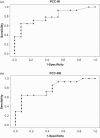The influence of (central) auditory processing disorder on the severity of speech-sound disorders in children
- PMID: 26934233
- PMCID: PMC4760364
- DOI: 10.6061/clinics/2016(02)02
The influence of (central) auditory processing disorder on the severity of speech-sound disorders in children
Abstract
Objective: To identify a cutoff value based on the Percentage of Consonants Correct-Revised index that could indicate the likelihood of a child with a speech-sound disorder also having a (central) auditory processing disorder .
Methods: Language, audiological and (central) auditory processing evaluations were administered. The participants were 27 subjects with speech-sound disorders aged 7 to 10 years and 11 months who were divided into two different groups according to their (central) auditory processing evaluation results.
Results: When a (central) auditory processing disorder was present in association with a speech disorder, the children tended to have lower scores on phonological assessments. A greater severity of speech disorder was related to a greater probability of the child having a (central) auditory processing disorder. The use of a cutoff value for the Percentage of Consonants Correct-Revised index successfully distinguished between children with and without a (central) auditory processing disorder.
Conclusions: The severity of speech-sound disorder in children was influenced by the presence of (central) auditory processing disorder. The attempt to identify a cutoff value based on a severity index was successful.
Conflict of interest statement
No potential conflict of interest was reported.
Figures



Similar articles
-
Auditory Processing and Speech-Sound Disorders.Brain Sci. 2024 Mar 19;14(3):291. doi: 10.3390/brainsci14030291. Brain Sci. 2024. PMID: 38539678 Free PMC article. Review.
-
The influence of (central) auditory processing disorder in speech sound disorders.Braz J Otorhinolaryngol. 2016 Jan-Feb;82(1):56-64. doi: 10.1016/j.bjorl.2015.01.008. Epub 2015 Oct 20. Braz J Otorhinolaryngol. 2016. PMID: 26612604 Free PMC article.
-
Differential Diagnosis of Speech Sound Disorder (Phonological Disorder): Audiological Assessment beyond the Pure-tone Audiogram.J Am Acad Audiol. 2015 Apr;26(4):423-35. doi: 10.3766/jaaa.26.4.9. J Am Acad Audiol. 2015. PMID: 25879245
-
Sensitivity and specificity of the Percentage of Consonants Correct-Revised in the identification of speech sound disorder.Codas. 2017 May 22;29(3):e20160038. doi: 10.1590/2317-1782/20172016038. Codas. 2017. PMID: 28538824 English, Portuguese.
-
A Computer-Based Speech Sound Disorder Screening System Architecture.Stud Health Technol Inform. 2018;251:39-42. Stud Health Technol Inform. 2018. PMID: 29968596 Review.
Cited by
-
Speech and language therapists' insights into severity of speech sound disorders in children for developing the speech sound disorder severity construct.Int J Lang Commun Disord. 2025 May-Jun;60(3):e70022. doi: 10.1111/1460-6984.70022. Int J Lang Commun Disord. 2025. PMID: 40139963 Free PMC article.
-
Auditory Processing and Speech-Sound Disorders.Brain Sci. 2024 Mar 19;14(3):291. doi: 10.3390/brainsci14030291. Brain Sci. 2024. PMID: 38539678 Free PMC article. Review.
-
Self-Perceived Stress and the Personality of Mothers of Children with Central Auditory Processing Disorder, as Well as in Mothers of Typically Developing Children, Before and Late in the COVID-19 Pandemic.Audiol Res. 2024 Oct 15;14(5):903-913. doi: 10.3390/audiolres14050076. Audiol Res. 2024. PMID: 39452468 Free PMC article.
-
Gaps-In-Noise Test Performance in Children with Speech Sound Disorder and Cognitive Difficulty.J Audiol Otol. 2020 Jul;24(3):133-139. doi: 10.7874/jao.2019.00381. Epub 2020 Feb 14. J Audiol Otol. 2020. PMID: 32050750 Free PMC article.
-
Contralateral suppression of transient evoked otoacoustic emissions in children with phonological disorder.Balkan Med J. 2021 Mar;38(2):127-132. doi: 10.4274/balkanmedj.galenos.2020.2020.4.168. Balkan Med J. 2021. PMID: 33283490 Free PMC article.
References
-
- Shriberg LD, Austin D, Lewis BA, McSweeny JL. The percentage of consonants correct (PCC) metric: extensions and reliability data. J Speech Lang Hear Res. 1997;40((4)):708–22. 10.1044/jslhr.4004.708 - DOI - PubMed
-
- Shriberg LD, Austin D, Lewis BA, McSweeny JL, Wilson DL. The speech disorders classification system (SDCS): extensions and lifespan reference data. J Speech Lang Hear Res. 1997;40((4)):723–40. 10.1044/jslhr.4004.723 - DOI - PubMed
-
- Wren Y, McLeod S, White P, Miller LL, Roulstone S. Speech characteristics of 8-year-old children: findings from a prospective population study. J Comm Disord. 2013;46((1)):53–69. 10.1016/j.jcomdis.2012.08.008 - DOI - PubMed
-
- Wertzner HF, Santos PI, Pagan-Neves LO. Speech errors in children with speech sound disorders according to otitis media history. Rev Soc Bras Fonoaudiol. 2012;17((4)):422–9. 10.1590/S1516-80342012000400010 - DOI
-
- Wertzner HF, Pagan-Neves LO. Effectiveness of complementary tests in monitoring therapeutic intervention in speech sound disorders. Rev Soc Bras Fonoaudiol. 2012;17((4)):469–75. 10.1590/S1516-80342012000400018 - DOI
MeSH terms
LinkOut - more resources
Full Text Sources
Other Literature Sources

